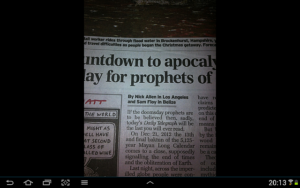As it happened, the stuff I sent through to the Telegraph ended up getting published. Here is a link: http://www.telegraph.co.uk/news/worldnews/maya/9759202/Mayan-apocalypse-ancient-city-of-Caracol-prepares-for-the-end-of-the-world.html
For this I wholly indebted to my university housemate Dan Johnson. He sorted out the contact, and was sent my jumble of words which he reordered into something eligible to publish. It should really read as written by us both I feel.
Nevertheless, here is the article. It was also used in their lead piece on “the end of the world”, so somehow managed to sneak my way onto the front page.
By Sam Floy in Caracol6:03PM GMT 20 Dec 2012
People from across the world have flocked to one of the sacred ancient Mayan sites ahead of the predicted end of the world.
Those attending the ruins of the 42-metre high temple, were planning to experience the winter solstice in the ancient city of Caracol in Belize as inhabitants over a thousand years ago would have done.
The event was oversubscribed with many people from across the globe hoping to understand how the Mayan civilisation celebrated major events. Others merely expected to witness events of a divine, or apocalyptic nature. Some bunkered down for the end of the world.
One visitor The Daily Telegraph spoke to, staying in the town of San Ignacio, 40 miles north of Caracol, explained on the eve of the solstice how cosmological patterns showed that “there was the possibility of a polar reversal” on the December 21
A second – who flew into the country from California earlier this week – speculated whether the ritual would “invoke past kings to reconnect with those present on the day, to bear warnings for the new era”.
The event at Belize’s Institute of Archaeology included a Guided tour of the ancient city, traditional Mayan meals and a fire ceremony to greet the new era at sunrise.
Dr Allan Moore, Associate Director at the Institute, said that their primary focus was making sure the event stayed true to traditional Mayan culture.
In a bid to achieve this, he said they invited shamans and elders from present-day Mayan communities in neighbouring Guatemala and Mexico, rather than hosting something more akin to “a rock concert”. He added that Belize is “at the heart of the Mayan region”.
The Mayan ruins of Caracol in Belize are normally off-limits to tourists, but a select group was preparing to camp overnight on Thursday to witness the passing of the 13th ‘baktun’, or ‘long count’.
December 21, 2012 marks the end of a 5,125-year cycle in the Maya Long Calendar, an event described by one leading US scholar in the 1960s as a kind of Armageddon for the Maya.
But today’s ethnic Mayans – mostly Christians – now look on in wonder and bewilderment at the influx of foreign tourists to ancient cities in southern Mexico and Central America.
Julian Nohuicab, 34, an ethnic Mayan drinks vendor working not far from Cancun, described it as “a date for doing business, but for me it’s just like any other day”.
Set in the Chiquibul forest, bordering what is now Guatemala, the city of Caracol was at the height of its powers between 450 and 850AD.
The ancient superstate defeated rival cities Tiakl (562 A.D.) and Naranjo (631 A.D) as it expanded its territory. The main temple, Caana, stands at 42 metres and looks out onto the once prosperous civilisation, which is now subsumed by vegetation.
By about 800AD, the Mayans were in decline, with warfare and agricultural crises potential explanations for the downfall. There are around six million Maya alive today.
Additional reporting by Daniel Johnson
